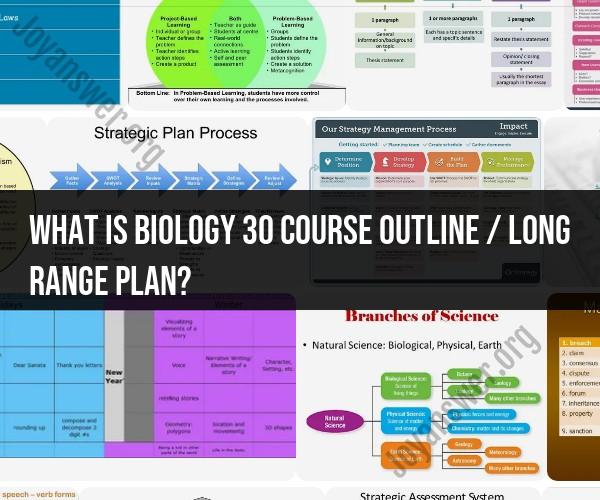What is Biology 30 course outline / long range plan?
Creating a course outline and a long-range plan for Biology 30 involves structuring the curriculum, setting objectives, and organizing the topics to be covered over the duration of the course. Here's an example of how you might map out the Biology 30 journey:
Course Outline for Biology 30:
Unit 1: Cellular Processes and Metabolism
- Cellular Respiration
- Photosynthesis
- Enzymes and Metabolic Pathways
- Cell Division and Mitosis
Unit 2: Molecular Genetics
- DNA Structure and Replication
- Protein Synthesis: Transcription and Translation
- Genetic Mutations and Repair Mechanisms
- Biotechnology and Genetic Engineering
Unit 3: Homeostasis and Regulation
- Endocrine System
- Nervous System
- Immune System and Disease
- Feedback Mechanisms and Homeostasis
Unit 4: Population and Community Dynamics
- Ecosystems and Biomes
- Population Growth and Regulation
- Ecological Interactions: Predation, Competition, Symbiosis
- Human Impact on Ecosystems and Biodiversity
Unit 5: Evolutionary Biology
- Natural Selection and Adaptation
- Speciation and Evolutionary Patterns
- Evidence for Evolution: Fossils, Homologous Structures
- Human Evolution and Genetics
Long-Range Plan:
Weeks 1-2: Unit 1 - Cellular Processes and Metabolism
- Introduction to Biology 30
- Cellular Respiration and ATP Production
- Photosynthesis and the Calvin Cycle
- Enzymes and Their Role in Metabolism
- Mitosis: Cell Cycle and Importance
Weeks 3-4: Unit 2 - Molecular Genetics
- DNA Structure and Replication Mechanism
- Transcription: From DNA to mRNA
- Translation: mRNA to Protein
- Genetic Mutations and Repair Mechanisms
Weeks 5-6: Unit 3 - Homeostasis and Regulation
- Endocrine System: Hormones and Glands
- Nervous System: Neurons and Synapses
- Immune System: Innate and Adaptive Immunity
- Feedback Mechanisms and Maintaining Homeostasis
Weeks 7-8: Unit 4 - Population and Community Dynamics
- Ecosystems: Abiotic and Biotic Factors
- Population Growth Models and Limiting Factors
- Ecological Interactions: Predation, Competition, Mutualism
- Human Impact on Ecosystems and Conservation
Weeks 9-10: Unit 5 - Evolutionary Biology
- Natural Selection and Selective Pressures
- Speciation and Isolation Mechanisms
- Evidence for Evolution: Fossils and Comparative Anatomy
- Human Evolution and Molecular Evidence
Weeks 11-12: Review and Assessments
- Comprehensive Review of Course Topics
- Summative Assessments: Exams, Projects, Presentations
- Course Reflection and Discussion
This is a general example of how you could structure the Biology 30 course outline and long-range plan. The specific topics covered, pacing, and sequencing can vary based on the curriculum guidelines, resources, and teaching methods you intend to use. It's important to align your plan with the learning objectives of the course and the needs of your students.













